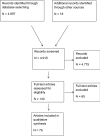The reality of general surgery training and increased complexity of abdominal wall hernia surgery
- PMID: 31754953
- PMCID: PMC6938469
- DOI: 10.1007/s10029-019-02062-z
The reality of general surgery training and increased complexity of abdominal wall hernia surgery
Abstract
Introduction: The Accreditation and Certification of Hernia Centers and Surgeons (ACCESS) Group of the European Hernia Society (EHS) recognizes that there is a growing need to train specialist abdominal wall surgeons. The most important and relevant argument for this proposal and statement is the growing acceptance of the increasing complexity of abdominal wall surgery due to newer techniques, more challenging cases and the required 'tailored' approach to such surgery. There is now also an increasing public awareness with social media, whereby optimal treatment results are demanded by patients. However, to date the complexity of abdominal wall surgery has not been properly or adequately defined in the current literature.
Methods: A systematic search of the available literature was performed in May 2019 using Medline, PubMed, Scopus, Embase, Springer Link, and the Cochrane Library, with 75 publications identified as relevant. In addition, an analysis of data from the Herniamed Hernia Registry was performed. The percentage of patients with hernia- or patient-related characteristics which unfavorably impacted the outcome of inguinal and incisional hernia repair was also calculated.
Results: All present guidelines for abdominal wall surgery recommend the utilization of a 'tailored' approach. This relies on the prerequisite that any surgical technique used has already been mastered, as well as the recognized learning curves for each of the several techniques that can be used for both inguinal hernia (Lichtenstein, TEP, TAPP, Shouldice) and incisional hernia repairs (laparoscopic IPOM, open sublay, open IPOM, open onlay, open or endoscopic component separation technique). Other hernia- and patient-related characteristics that have recognized complexity include emergency surgery, obesity, recurrent hernias, bilateral inguinal hernias, groin hernia in women, scrotal hernias, large defects, high ASA scores, > 80 years of age, increased medical risk factors and previous lower abdominal surgery. The proportion of patients with at least one of these characteristics in the Herniamed Hernia Registry in the case of both inguinal and incisional hernia is noted to be relatively high at around 70%. In general surgery training approximately 50-100 hernia repairs on average are performed by each trainee, with around only 25 laparo-endoscopic procedures.
Conclusion: A tailored approach is now employed and seen more so in hernia surgery and this fact is referred to and highlighted in the contemporaneous hernia guidelines published to date. In addition, with the increasing complexity of abdominal wall surgery, the number of procedures actually performed by trainees is no longer considered adequate to overcome any recognized learning curve. Therefore, to supplement general surgery training young surgeons should be offered a clinical fellowship to obtain an additional qualification as an abdominal wall surgeon and thus improve their clinical and operative experience under supervision in this field. Practicing general surgeons with a special interest in hernia surgery can undertake intensive further training in this area by participating in clinical work shadowing in hernia centers, workshops and congresses.
Keywords: Complex hernias; Incisional hernia; Inguinal hernia; Learning curve; Surgical training; Tailored approach.
Conflict of interest statement
All authors declare no conflicts of interest.


